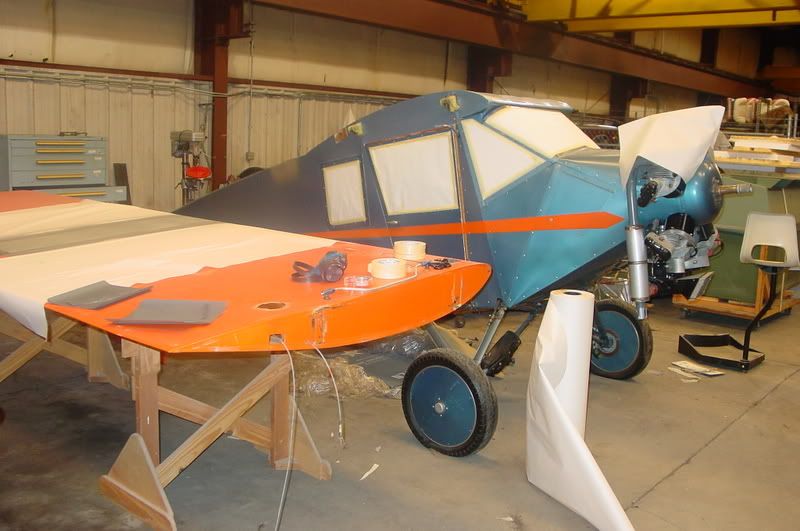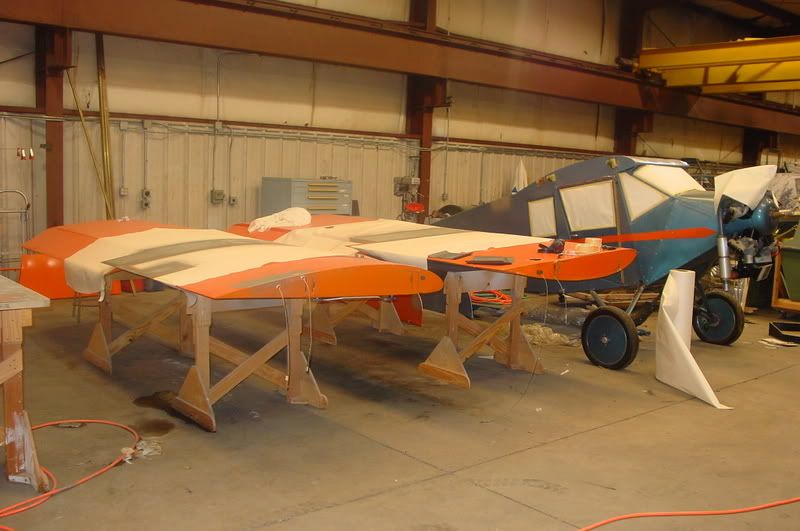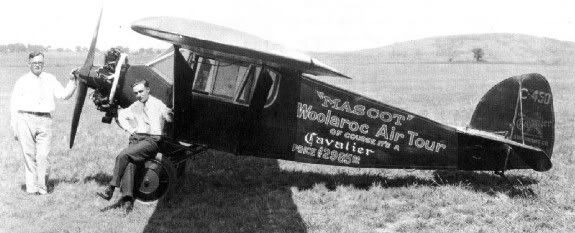Painting a Fabric-Covered Aircraft
Thu May 08, 2008 10:14 pm
Okay... this is a question for those of you who have painted a vintage aircraft.
Is there anything particularly unique/difficult about painting a vintage, fabric-covered aircraft? Obviously the nature of the aircraft having a fabric covered surface versus a metal surface makes it more delicate and requires a little more care. Is there anything special that has to be done to the surface before painting? Let me be more specific:
We have an aircraft that was covered in the 1960s that is in good shape. It is going to be a static museum display, and will not be flown any time in the future. It has an older paint job on it presently, and needs a new paint job before going on display. We don't have a facility to paint the aircraft. Its wings are off of the aircraft at the moment, and the fuselage would nicely fit on a trailer. Would there be anything wrong with taking the fuselage and wings to an auto shop and having them shoot the aircraft with a high-quality paint? Is there any prep that is different? Any type of paint that should/shouldn't be used?
Thanks!
kevin
Is there anything particularly unique/difficult about painting a vintage, fabric-covered aircraft? Obviously the nature of the aircraft having a fabric covered surface versus a metal surface makes it more delicate and requires a little more care. Is there anything special that has to be done to the surface before painting? Let me be more specific:
We have an aircraft that was covered in the 1960s that is in good shape. It is going to be a static museum display, and will not be flown any time in the future. It has an older paint job on it presently, and needs a new paint job before going on display. We don't have a facility to paint the aircraft. Its wings are off of the aircraft at the moment, and the fuselage would nicely fit on a trailer. Would there be anything wrong with taking the fuselage and wings to an auto shop and having them shoot the aircraft with a high-quality paint? Is there any prep that is different? Any type of paint that should/shouldn't be used?
Thanks!
kevin
Thu May 08, 2008 11:33 pm
Fabric is flexible. Most auto finishes are not. If you must use auto paint, add a flex agent like they use for rubber bumper covers.
If the plane is finished with dope, you can rejuvinate the fabric (if required due to cracking of the dope) and refinish again with dope. You can use butyrate dope over nitrate, but not the other way around.
I think taking this to an automotive shop is a bad idea. Do't let them convince you otherwise, I don't care how good they think they are! Unless they are familiar with fabric aircraft, you better not let them do ANY sanding. They will sand right through the fabric over any stiffeners or ribs and ruin the fabric. All sanding has to be done by hand!
http://www.aircraftspruce.com/catalog/c ... manual.php
If the plane is finished with dope, you can rejuvinate the fabric (if required due to cracking of the dope) and refinish again with dope. You can use butyrate dope over nitrate, but not the other way around.
I think taking this to an automotive shop is a bad idea. Do't let them convince you otherwise, I don't care how good they think they are! Unless they are familiar with fabric aircraft, you better not let them do ANY sanding. They will sand right through the fabric over any stiffeners or ribs and ruin the fabric. All sanding has to be done by hand!
http://www.airweb.faa.gov/Regulatory_and_Guidance_Library/rgAdvisoryCircular.nsf/0/99c827db9baac81b86256b4500596c4e/$FILE/Chapter%2002.pdf
2-35. REJUVENATION OF THE DOPE
FILM. If fabric loses its strength, there is
nothing to do but remove it and recover the
aircraft. But if the fabric is good and the dope
is cracked, it may be treated with rejuvenator, a
mixture of very potent solvents and plasticizers,
to restore its resilience. The surface of the
fabric is cleaned and the rejuvenator sprayed
on in a wet coat, and the solvents soften the
old finish so the plasticizers can become part
of the film. When the rejuvenator dries, the
surface should be sprayed with two coats of
aluminum-pigmented dope, then sanded and a
third coat of aluminum-pigmented dope applied,
followed with the colored-dope finish.
When repairing, rejuvenating, and refinishing
covering materials approved under an STC, instructions
in the manual furnished by the material
supplier should be followed.
http://www.aircraftspruce.com/catalog/c ... manual.php
Thu May 08, 2008 11:52 pm
Ok... so auto paint is a bad idea. Tell me about the difference between "aircraft paint" and auto paint. Is the technique to paint the aircraft the same (spray gun applied), just different materials need to be used?
The aircraft, as I said, has an existing coat of paint on it that is in great shape; there were just a few small repairs made to the fabric that have been properly finished with dope applied, and are just waiting for color. Additionally, the curator wants to change the paint scheme on the aircraft so it needs a total repaint. Can we just get the proper materials and shoot the aircraft?
The aircraft, as I said, has an existing coat of paint on it that is in great shape; there were just a few small repairs made to the fabric that have been properly finished with dope applied, and are just waiting for color. Additionally, the curator wants to change the paint scheme on the aircraft so it needs a total repaint. Can we just get the proper materials and shoot the aircraft?
Fri May 09, 2008 12:13 am
The difference is not auto paint vs. aircraft paint, but fabric paint vs. metal paint. It is all in the plasticizers used in the paint formulation. You can use auto paint with flex agent, but if you ever have to repair it, it is more difficult to make it look good.tulsaboy wrote:Ok... so auto paint is a bad idea. Tell me about the difference between "aircraft paint" and auto paint. Is the technique to paint the aircraft the same (spray gun applied), just different materials need to be used?
The aircraft, as I said, has an existing coat of paint on it that is in great shape; there were just a few small repairs made to the fabric that have been properly finished with dope applied, and are just waiting for color. Additionally, the curator wants to change the paint scheme on the aircraft so it needs a total repaint. Can we just get the proper materials and shoot the aircraft?
If the existing dope finish is in good shape, I would clean it really well to remove any waxes and oils and respray with dope. The solvents in the new dope will soften the dope below somewhat and should adhere well. If you have stripes to remove it gets a little harder because you will have to do some sanding to feather the edges. You might want to spray a coat of silver dope first to prevent any bleed through of color and then spray your color coat. The silver dope acts like a high build primer (it has aluminum powder in it) so you can do a little wet sanding between coats of silver dope to hide any previously feathered edges.
As for the spraying, there is nothing easier to spray than dope in my opinion. You really have to lay it on thick to get a run. A nice wet coat (with some fast or slow reducer depending on the temperature) will also ensure you don't get dry spots in the finish. In any case you can rub out the final finish to a nice gloss.
Although I have done some of this, I'm not a refinishing expert. Most of what I have done is from new. Maybe someone like Gary has some additional insight?
Gary, would you spray reducer first to soften things up before recoating?
Fri May 09, 2008 6:22 am
I dunno, y'all. Like BDK, I typically start from new on fabric jobs, and I rarely mess with the old school way of doing things with coat after coat of silver (although that works quite well). I'm an Air Tec guy and use that system because it's easy...and light (for the racer). I'm not really an expert at anything. However, when I get in a bind, I know the right people to ask. In this case, WIX isn't a bad idea. So far, I don't disagree with anything BDK has said regarding this, but maybe if you also called some folks that do this type of work for a living, they could help you out.
Have fun. This stuff is neat to learn.
Gary
Have fun. This stuff is neat to learn.
Gary
Fri May 09, 2008 9:18 am
Alright, so it sounds like the best idea, based on bdk's suggestion, would be to feather the stripe edges gently, spray a few coats of dope, and follow with a color top coat and then maybe a clear top coat?
Below are a couple of photos of the aircraft, which is a Star Cavalier. Also pictured is the probable paint scheme. We are here in Tulsa, just 45 miles from Bartlesville, where the Star aircraft were built.
Keep the advice coming! It's great to learn new stuff.
kevin



Below are a couple of photos of the aircraft, which is a Star Cavalier. Also pictured is the probable paint scheme. We are here in Tulsa, just 45 miles from Bartlesville, where the Star aircraft were built.
Keep the advice coming! It's great to learn new stuff.
kevin



Fri May 09, 2008 12:21 pm
No clear coat on fabric back in the day. You just rub out the dope finish.tulsaboy wrote:Alright, so it sounds like the best idea, based on bdk's suggestion, would be to feather the stripe edges gently, spray a few coats of dope, and follow with a color top coat and then maybe a clear top coat?
There may be some newfangled clearcoats for fabric, but I haven't looked into that aspect. Definitely not period correct. Untinted dope is kind of milky, so that won't work as a clearcoat.
To reiterate, be very careful when sanding. Try not to sand through the silver that is under the paint. Watch especially for hard edges that are easy to sand through (ribs and rib stitching for instance). Imagine what would happen to a cotton shirt of you pulled it tightly over the edge of a table and sanded on the corner.
Fri May 09, 2008 1:16 pm
Kevin-
BDK is absolutely correct about the need for additional plasticizers, flex agents, in automotive poly paint used on fabric aircraft. However auto enamel and lacquer can be used from the can with quite good results. In the 60's we would often refresh an old dope job with a quick respray for our flight school aircraft, while it made repair more difficult it looked good and cracking was not as evident as we get from poly on fabric today. The best option is auto lacquer since dope is basically a lacquer. Both dope and lacquer can be used as paint remover when applied over enamel but you can spray enamel over both dope and lacquer with no effect. Keep that in mind because the metal on you Star may not be dope if you respray with dope.
Use of rejuvinator is not as simple as simply spraying, if there is ringworm you will need to soak the area in question to soften the brittle dope and work it by hand. Because this is for display I would not respray with silver and for a flyer would only do so if there was a problem noted when looking inside the wing when shining a light on the upper surface because silver can made adhesion difficult.
Given that it is a display aircraft I would carefully prep sand and spray with a good lacquer, like dope lacquer is easy to apply.
Tom-
BDK is absolutely correct about the need for additional plasticizers, flex agents, in automotive poly paint used on fabric aircraft. However auto enamel and lacquer can be used from the can with quite good results. In the 60's we would often refresh an old dope job with a quick respray for our flight school aircraft, while it made repair more difficult it looked good and cracking was not as evident as we get from poly on fabric today. The best option is auto lacquer since dope is basically a lacquer. Both dope and lacquer can be used as paint remover when applied over enamel but you can spray enamel over both dope and lacquer with no effect. Keep that in mind because the metal on you Star may not be dope if you respray with dope.
Use of rejuvinator is not as simple as simply spraying, if there is ringworm you will need to soak the area in question to soften the brittle dope and work it by hand. Because this is for display I would not respray with silver and for a flyer would only do so if there was a problem noted when looking inside the wing when shining a light on the upper surface because silver can made adhesion difficult.
Given that it is a display aircraft I would carefully prep sand and spray with a good lacquer, like dope lacquer is easy to apply.
Tom-
???
Sat May 10, 2008 4:43 pm
Kevin,
Give Jeff a blast. I swear he's a walking encyclopedia of all things fabric.
I guess it's a requirement if you're a antique guy.
BTW Jeff says find a C3B Stearman.
Give Jeff a blast. I swear he's a walking encyclopedia of all things fabric.
I guess it's a requirement if you're a antique guy.
BTW Jeff says find a C3B Stearman.
Sun May 11, 2008 7:37 am
Any of the man made newer processes would work fine. I would recommend rejunvinating it weither it had ringworm or not, light sand and re-spray with one of the new fabric finishes. I allways had good luck with the Poly Fiber process.
Sun May 11, 2008 1:29 pm
If you glop on this modern plastic paint (not dope), do the poor old bird a favor, at least to keep it's dignity intact and lend it some respect. Mix in about 20% DuPont 4531S flattener (if you are really cheap then use talc). That ship never was highly glossy when she was young and glossing it up is not representative nor respectful of history. Even car restorers are now finally coming to the realization that what rebuilds look like now, are not what Detroit produced 50 years past. It is a 30's rarity you have care of....not a Bonanza. It should look like one.
Mon May 12, 2008 12:07 am
Kevin,
I don't know any more about dope and fab than I do radial engines, but I would like to ask a question: Do you know where the original photo of the Woolaroc Cavalier was taken? The background scenery looks familiar, but I would like to know if the photo had a caption or location on it.
Thanks,
Scott
I don't know any more about dope and fab than I do radial engines, but I would like to ask a question: Do you know where the original photo of the Woolaroc Cavalier was taken? The background scenery looks familiar, but I would like to know if the photo had a caption or location on it.
Thanks,
Scott
Mon May 12, 2008 11:09 am
Thanks for the advice, folks. I'm trying to make sure it's done right, and that we don't cause any harm in the process. Your words of wisdom are appreciated. I'll make sure to show you the finished result.
Scott- I don't know where that shot came from. It's wandered around the web some. I found it first here-
http://www.goldenageair.org/collection/1929starb.htm
It's possible that it was taken at Bartlesville, where the aircraft were built, presumably at Bartlesville's little airport.
kevin
Scott- I don't know where that shot came from. It's wandered around the web some. I found it first here-
http://www.goldenageair.org/collection/1929starb.htm
It's possible that it was taken at Bartlesville, where the aircraft were built, presumably at Bartlesville's little airport.
kevin
Mon May 12, 2008 12:44 pm
Thanks for the info, Kevin.
I'll try to match up the topography on Friday when we pull the airplane out. We base out of BVO, and I'll see if that hill looks right when we head to Houston. Cool photo!
Scott
I'll try to match up the topography on Friday when we pull the airplane out. We base out of BVO, and I'll see if that hill looks right when we head to Houston. Cool photo!
Scott
Wed May 14, 2008 9:37 pm
There's also a catch for Stitts fabric users - there's an STC out there that says only Stitts-brand butyrates (dopes/paints) can be used on Stitts fabric. It really cheats you on the color, because they don't have as many stock colors that match original paint schemes.